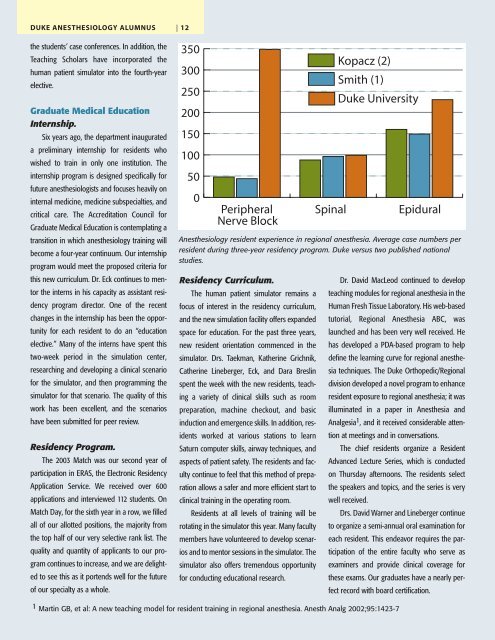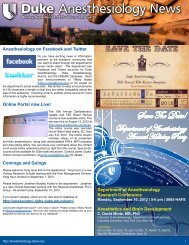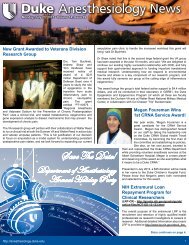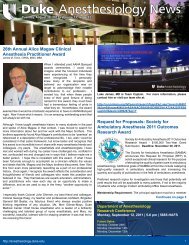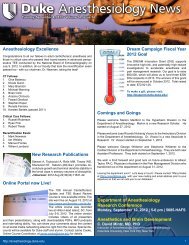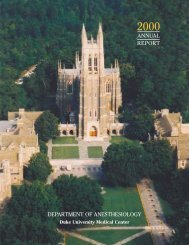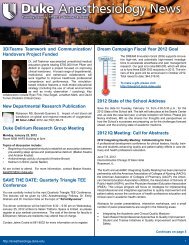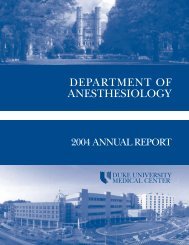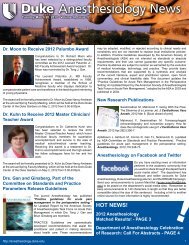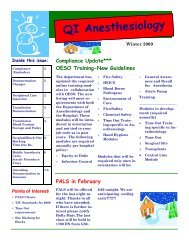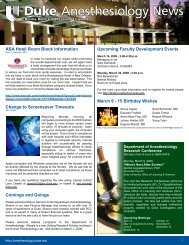04 wint anes alum single pgs - Department of Anesthesiology - Duke ...
04 wint anes alum single pgs - Department of Anesthesiology - Duke ...
04 wint anes alum single pgs - Department of Anesthesiology - Duke ...
Create successful ePaper yourself
Turn your PDF publications into a flip-book with our unique Google optimized e-Paper software.
DUKE ANESTHESIOLOGY ALUMNUS | 12<br />
the students’ case conferences. In addition, the<br />
Teaching Scholars have incorporated the<br />
human patient simulator into the fourth-year<br />
elective.<br />
Graduate Medical Education<br />
Internship.<br />
Six years ago, the department inaugurated<br />
a preliminary internship for residents who<br />
wished to train in only one institution. The<br />
internship program is designed specifically for<br />
future <strong>anes</strong>thesiologists and focuses heavily on<br />
internal medicine, medicine subspecialties, and<br />
critical care. The Accreditation Council for<br />
Graduate Medical Education is contemplating a<br />
transition in which <strong>anes</strong>thesiology training will<br />
become a four-year continuum. Our internship<br />
program would meet the proposed criteria for<br />
this new curriculum. Dr. Eck continues to mentor<br />
the interns in his capacity as assistant residency<br />
program director. One <strong>of</strong> the recent<br />
changes in the internship has been the opportunity<br />
for each resident to do an “education<br />
elective.” Many <strong>of</strong> the interns have spent this<br />
two-week period in the simulation center,<br />
researching and developing a clinical scenario<br />
for the simulator, and then programming the<br />
simulator for that scenario. The quality <strong>of</strong> this<br />
work has been excellent, and the scenarios<br />
have been submitted for peer review.<br />
Residency Program.<br />
The 2003 Match was our second year <strong>of</strong><br />
participation in ERAS, the Electronic Residency<br />
Application Service. We received over 600<br />
applications and interviewed 112 students. On<br />
Match Day, for the sixth year in a row, we filled<br />
all <strong>of</strong> our allotted positions, the majority from<br />
the top half <strong>of</strong> our very selective rank list. The<br />
quality and quantity <strong>of</strong> applicants to our program<br />
continues to increase, and we are delighted<br />
to see this as it portends well for the future<br />
<strong>of</strong> our specialty as a whole.<br />
350<br />
300<br />
250<br />
200<br />
150<br />
100<br />
50<br />
0<br />
<strong>Anesthesiology</strong> resident experience in regional <strong>anes</strong>thesia. Average case numbers per<br />
resident during three-year residency program. <strong>Duke</strong> versus two published national<br />
studies.<br />
Residency Curriculum.<br />
The human patient simulator remains a<br />
focus <strong>of</strong> interest in the residency curriculum,<br />
and the new simulation facility <strong>of</strong>fers expanded<br />
space for education. For the past three years,<br />
new resident orientation commenced in the<br />
simulator. Drs. Taekman, Katherine Grichnik,<br />
Catherine Lineberger, Eck, and Dara Breslin<br />
spent the week with the new residents, teaching<br />
a variety <strong>of</strong> clinical skills such as room<br />
preparation, machine checkout, and basic<br />
induction and emergence skills. In addition, residents<br />
worked at various stations to learn<br />
Saturn computer skills, airway techniques, and<br />
aspects <strong>of</strong> patient safety. The residents and faculty<br />
continue to feel that this method <strong>of</strong> preparation<br />
allows a safer and more efficient start to<br />
clinical training in the operating room.<br />
Residents at all levels <strong>of</strong> training will be<br />
rotating in the simulator this year. Many faculty<br />
members have volunteered to develop scenarios<br />
and to mentor sessions in the simulator. The<br />
simulator also <strong>of</strong>fers tremendous opportunity<br />
for conducting educational research.<br />
Dr. David MacLeod continued to develop<br />
teaching modules for regional <strong>anes</strong>thesia in the<br />
Human Fresh Tissue Laboratory. His web-based<br />
tutorial, Regional Anesthesia ABC, was<br />
launched and has been very well received. He<br />
has developed a PDA-based program to help<br />
define the learning curve for regional <strong>anes</strong>thesia<br />
techniques. The <strong>Duke</strong> Orthopedic/Regional<br />
division developed a novel program to enhance<br />
resident exposure to regional <strong>anes</strong>thesia; it was<br />
illuminated in a paper in Anesthesia and<br />
Analgesia1 , and it received considerable attention<br />
at meetings and in conversations.<br />
The chief residents organize a Resident<br />
Advanced Lecture Series, which is conducted<br />
on Thursday afternoons. The residents select<br />
the speakers and topics, and the series is very<br />
well received.<br />
Drs. David Warner and Lineberger continue<br />
to organize a semi-annual oral examination for<br />
each resident. This endeavor requires the participation<br />
<strong>of</strong> the entire faculty who serve as<br />
examiners and provide clinical coverage for<br />
these exams. Our graduates have a nearly perfect<br />
record with board certification.<br />
1 Martin GB, et al: A new teaching model for resident training in regional <strong>anes</strong>thesia. Anesth Analg 2002;95:1423-7


